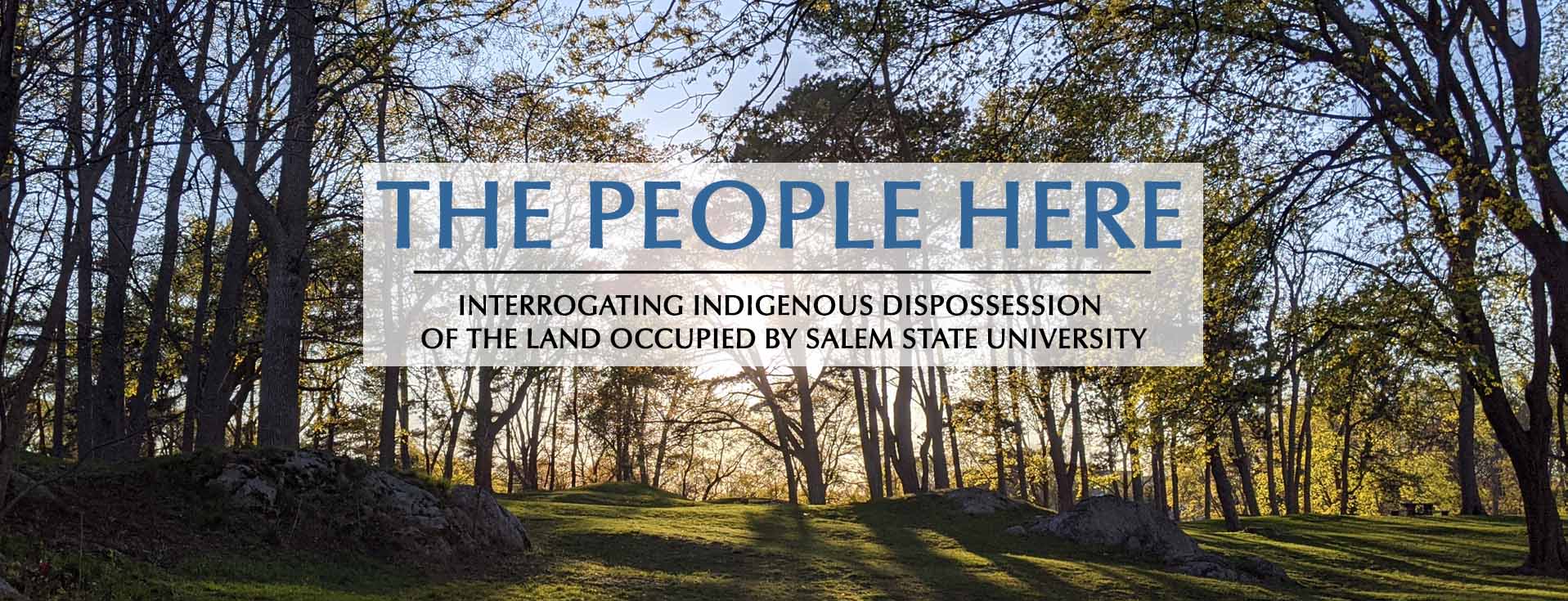Terminology
Throughout this project, we have been mindful of our use of settler-constructed frameworks and terminology, while also knowing the limits of our knowledge of the deep history of the original people here. We acknowledge that by writing this project in English, we are confined to the language of the settlers, which is laced with colonial values. The words and phrases below are terms that, given our limitations, best describe our intentions.
Because words like tribe and nation are terms that the European settlers applied to Native people in order to make them more legible, and because there is currently no known organization of Naumkeag people, we have chosen to use the more neutral term group to refer to them.
Dawnland is the English translation of various Algonkian-language words that define the original people and places of northeastern Turtle Island (explained below) as “people of the dawn.” The term refers to the fact that the sun rises in the east, thus naming the east coast as the land of dawn.
Indigenous, Native, and original people are terms we use interchangeably to broadly refer to people indigenous to this continent.
Eastern Algonkian (also spelled Algonquian; pronounced al·gahng·kee·uhn) refers broadly to the culture and people of Dawnland. The Naumkeag and other people described in this project are part of the Algonkian language family, spanning from present-day New England throughout what we today call southeastern Canada. Groups within the Algonkian language family have their own distinct characteristics, but share foundational language features, as well as some cultural, social, political, and spiritual practices. In this project, when we speak of the earliest original people of Dawnland, we are referring broadly to the lifeways of the Algonkian language group, which includes numerous other Indigenous groups of Dawnland like the Wampanoag, the Mohegan, and the Pequot. Including within the Eastern Algonkian people are the Wabanaki people of northern Dawnland, including but not limited to the Abanaki, Mi'kmaq, Maliseet, Passamaquoddy and Penobscot communities.
Turtle Island is the English translation of the Algonkian- and Iroquois-language terms for the land also known as North and Central America. The term refers to common creation stories that describe the Earth as the back of a turtle, and thus is also used to mean the world itself.
Naumkeag refers to the Eastern Algonkian people of the land that is today known as the towns of Salem, Beverly, Danvers, Peabody, and Marblehead, Massachusetts. Because of their early contact with colonists, who brought with them diseases and an equally deadly desire for conquest, there is much that we simply do not know about the earliest original people of this area. One unknown is their name. While some Indigenous people and historians believe that the people who lived at the village called Naumkeag identified themselves as the Naumkeag, others believe that the settlers mistakenly applied a place name to a people. The spelling of Naumkeag is similarly uncertain, since it is a word phonetically transcribed and disseminated by the colonists; while it appears in Euroamerican histories as Naumkeag (pronounced nom-kee-ag), historians like Mary Ellen Lepionka posit that the name was likely Nahumkeak (pronounced nom-kee-ak). Historians translate Naumkeag as “the fishing place,” while Lepionka translate Nahumkeak to mean “here are eels.” Both meanings refer to the Wahquack River (the present-day Bass River), which was a source of sustenance for the people at Naumkeag.
Pawtucket and Pawtucket-Pennacook refer to the Indigenous people of the Merrimack Valley in present-day northern Massachusetts and southern New Hampshire. Settler historical accounts tend to group the people at Naumkeag together with the Pawtucket people to the north, organizing them into the Pawtucket tribe and the larger Pennacook nation. Abanaki scholar Lisa Brooks notes that at the time of initial settler-colonial settlement, the Naumkeag and their neighbors were led by the sachem Nanepashemet, who had ties to the Pawtucket homelands to the north, and his wife, the Sunksqua of the Massachusett people to the south. Their marriage likely reinforced an alliance between these two broad and fluid groups, thus further blurring the line between the Pawtucket-Pennacook and the Massachusett.
The Massachusett people are a tribe (from which the settler Commonwealth of Massachusetts took its name) who name themselves as the present-day stewards of Naumkeag. In this project, we describe the people at Naumkeag as members of the broader Massachusett community.
Leadership among the Pawtucket and Massachusett people: Solomon notes that Euroamerican narratives of Native male leaders like Nanepashemet and Masconomet impose a patriarchal framework that falsely frames the people at Naumkeag and other Massachusett communities as patrilineal and only led by men. The existence of the Massachusett-language term sunksqua, which means “female leader” or “sachem,” offers proof to the contrary, suggesting that women leaders are common and have existed long before the colonial invasion.
Regarding gender: Prior to European contact, the Algonkian peoples’ worldview likely recognizes three to five (or perhaps more) gender positions. These gender positions are mobile categories that are defined by their own specific terminology. Later, when the European colonizers arrive, they impose their culture’s patriarchal gender binary on the original people they encounter. Therefore although many historical accounts describe the people of Dawnland as men and women, we must keep in mind that these are settler-imposed ideologies. (For more information on gender in Native cultures, click here .)

